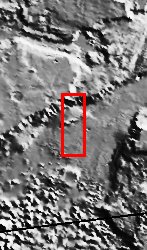
Released 16 October 2003
The slopes and floor of Eos Chasma, a portion of the vast Valles Marineris canyon complex, are located near an early landing site for the MER rovers. Sadly, this site was eliminated due to serious concerns about winds. Nevertheless, this site contains some marvelous geology. Layered rocks abound in the walls of the canyon as well as in the large streamlined material on the floor. The streamlined island appears to have been formed in a massive flood episode. Alluvial fans can also be seen at the base of the slopes. One fan has a deeply entrenched channel that was most likely carved out by water; however, it may be possible that dry avalanches created this channel.
Image information: VIS instrument. Latitude -13.5, Longitude 317.8 East (42.2 West). 19 meter/pixel resolution.
Note: this THEMIS visual image has not been radiometrically nor geometrically calibrated for this preliminary release. An empirical correction has been performed to remove instrumental effects. A linear shift has been applied in the cross-track and down-track direction to approximate spacecraft and planetary motion. Fully calibrated and geometrically projected images will be released through the Planetary Data System in accordance with Project policies at a later time.
NASA's Jet Propulsion Laboratory manages the 2001 Mars Odyssey mission for NASA's Office of Space Science, Washington, D.C. The Thermal Emission Imaging System (THEMIS) was developed by Arizona State University, Tempe, in collaboration with Raytheon Santa Barbara Remote Sensing. The THEMIS investigation is led by Dr. Philip Christensen at Arizona State University. Lockheed Martin Astronautics, Denver, is the prime contractor for the Odyssey project, and developed and built the orbiter. Mission operations are conducted jointly from Lockheed Martin and from JPL, a division of the California Institute of Technology in Pasadena.

